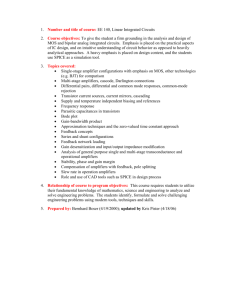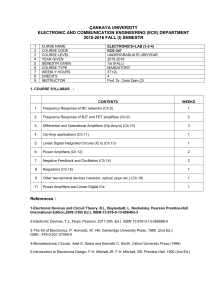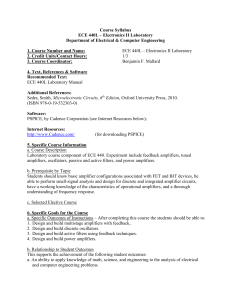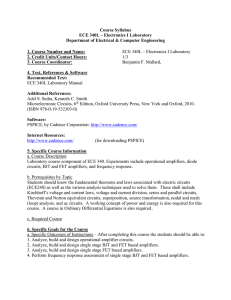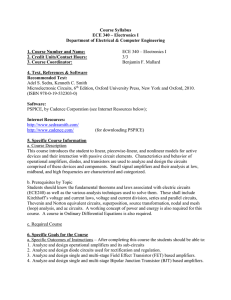ECE 372 Electronics II - Electrical and Computer Engineering
advertisement
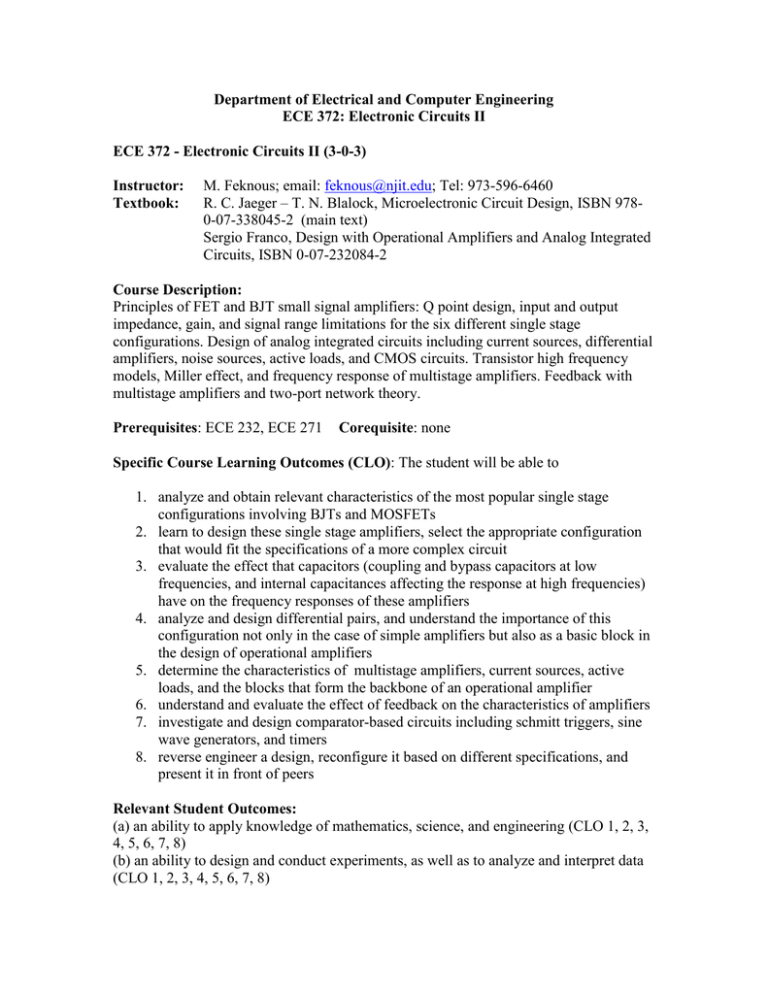
Department of Electrical and Computer Engineering ECE 372: Electronic Circuits II ECE 372 - Electronic Circuits II (3-0-3) Instructor: Textbook: M. Feknous; email: feknous@njit.edu; Tel: 973-596-6460 R. C. Jaeger – T. N. Blalock, Microelectronic Circuit Design, ISBN 9780-07-338045-2 (main text) Sergio Franco, Design with Operational Amplifiers and Analog Integrated Circuits, ISBN 0-07-232084-2 Course Description: Principles of FET and BJT small signal amplifiers: Q point design, input and output impedance, gain, and signal range limitations for the six different single stage configurations. Design of analog integrated circuits including current sources, differential amplifiers, noise sources, active loads, and CMOS circuits. Transistor high frequency models, Miller effect, and frequency response of multistage amplifiers. Feedback with multistage amplifiers and two-port network theory. Prerequisites: ECE 232, ECE 271 Corequisite: none Specific Course Learning Outcomes (CLO): The student will be able to 1. analyze and obtain relevant characteristics of the most popular single stage configurations involving BJTs and MOSFETs 2. learn to design these single stage amplifiers, select the appropriate configuration that would fit the specifications of a more complex circuit 3. evaluate the effect that capacitors (coupling and bypass capacitors at low frequencies, and internal capacitances affecting the response at high frequencies) have on the frequency responses of these amplifiers 4. analyze and design differential pairs, and understand the importance of this configuration not only in the case of simple amplifiers but also as a basic block in the design of operational amplifiers 5. determine the characteristics of multistage amplifiers, current sources, active loads, and the blocks that form the backbone of an operational amplifier 6. understand and evaluate the effect of feedback on the characteristics of amplifiers 7. investigate and design comparator-based circuits including schmitt triggers, sine wave generators, and timers 8. reverse engineer a design, reconfigure it based on different specifications, and present it in front of peers Relevant Student Outcomes: (a) an ability to apply knowledge of mathematics, science, and engineering (CLO 1, 2, 3, 4, 5, 6, 7, 8) (b) an ability to design and conduct experiments, as well as to analyze and interpret data (CLO 1, 2, 3, 4, 5, 6, 7, 8) (c) an ability to design a system, component, or process to meet desired needs within realistic constraints such as economic, environmental, social, political, ethical, health and safety, manufacturability, and sustainability (CLO 2, 4, 7, 8) (e) an ability to identify, formulate, and solve engineering problems (CLO 7, 8) (f) an understanding of professional and ethical responsibility (CLO 8) (g) an ability to communicate effectively (CLO 8) (i) a recognition of the need for, and an ability to engage in life-long learning (CLO 2, 4, 5, 7, 8) (j) a knowledge of contemporary issues (CLO 7, 8) (k) an ability to use the techniques, skills, and modern engineering tools necessary for engineering practice (CLO 4, 7, 8) Computer assisted design and course specific software: PSpice, Multisim, Excel, Matlab Topics: Topic Analog systems Two-port networks Ideal operational amplifiers Operational amplifier-based circuits Small-signal modeling BJT amplifiers MOSFET amplifiers Single and multistage amplifiers Common emitter, common source Common collector, common drain Coupling and bypass capacitor design Multistage AC-coupled amplifiers Nonlinear Circuits Transistor feedback amplifiers Comparators Applications: ON-OFF Control, Window Detectors, Schmitt Triggers Filters and Signal Generators Active filters Oscillators multivibrators Midterm exam #1 Differential amplifier DC and AC analyses Differential-mode gain, common-mode gain, common-mode rejection ratio Input and output resistances Transition to operational amplifiers Output stages Week 1-2 2-3 4-5 5-6 6-7 7 8-9 Current Sources and Feedback MOSFET Current Sources BJT Current Sources Buffered Current Sources Widlar Current Sources Feedback Amplifier frequency response Estimation of ωL using the short-circuit-time-constant method Transistor models at high frequencies Estimation of ωH using the Open-circuit-time-constant method Midterm exam #2, group project presentation, review Final exam 10 10-11 12-14 15 Grading: Class participation, Homework 10%, quizzes 15%; Group project including simulation 15%; (demonstration: extra credit except for honor students); Mid-term examinations 2 x 15%; Final examination 30%. Homework Problems: Chapter Problems 10 14, 17, 54, 66, 13 11, 22, 30, 34, 65, 66, 68 14 1, 20, 28, 74, 114 15 4, 24, 51, 58, 71, 116, 122 17 9, 18, 40, 45, 58, 60 Date of submission will be announced in class. The topics of the class project will be selected by groups of students and approved by the instructor no later than 4 weeks after the beginning of the semester. The project topic should be about mastering an existing design, then manipulating the design to fit the specifications related to another application that will benefit from that design. Each group should elect a project manager to interact with the instructor, and manage the project. Honor Code: The NJIT Honor Code will be upheld, and any violations will be brought to the immediate attention of the Dean of Students. Office: ECEC 311 Office hours: T 10:30 AM - 11:20 AM W 11:30 AM – 12:45 PM R 1:00 PM - 2:25 PM F 10:30 AM - 11:20 AM through appointment Other times can be arranged through appointments Times may change if more convenient choices for the students are found Prepared by: M. Feknous
